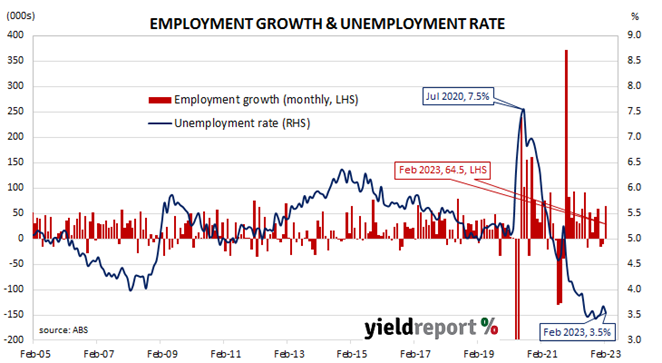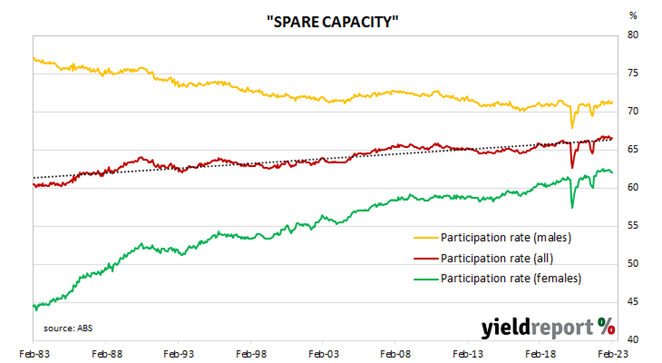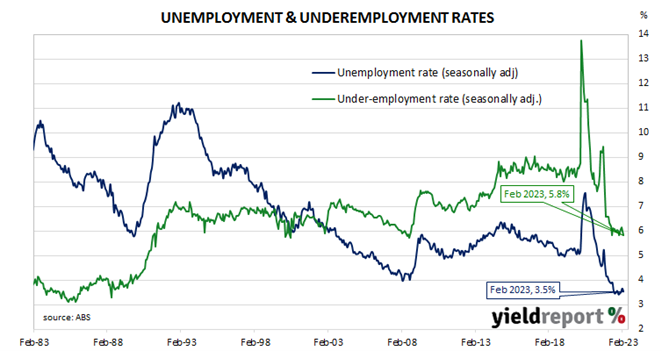Summary: Employment up 64,500 in February, greater than expected; Westpac: labour market has begun year on firm trend; MSA: trajectory still one of weaker conditions; participation rate ticks up to 66.6%; jobless rate down from 3.7% to 3.5%; fewer part-time, more full-time jobs; aggregate work hours up 3.9%; underemployment rate falls to 5.8%.
Australia’s period of falling unemployment came to an end in early 2019 when the jobless rate hit a low of 4.9%. It then averaged around 5.2% through to March 2020, bouncing around in a range from 5.1% to 5.3%. Leading indicators such as ANZ’s Job Ads survey and NAB’s capacity utilisation estimate suggested the unemployment rate would rise in the June 2020 quarter and it did so, sharply. The jobless rate peaked in July 2020 but fell below 7% a month later and then trended lower through 2021 and 2022.
The latest Labour force figures have now been released and they indicate the number of people employed in Australia according to ABS definitions increased by 64,500 in February. The rise was greater than the 50,000 increase which had been generally expected and in contrast with January’s 10,900 loss after revisions.
“Overall, the February report does suggest that the Australian labour market has begun the year on a firm trend, though we do expect outcomes to soften moving into the second half of the year,” said Westpac senior economist Justin Smirk.
Domestic Treasury bond yields fell heavily on the day, especially at the short end, following similar movements from US Treasury yields overnight. By the close of business, the 3-year ACGB yield had dropped by 25bps to 2.82%, the 10-year yield had lost 10bps to 3.34% while the 20-year yield finished 3bps lower at 3.84%.
In the cash futures market, expectations regarding future rate rises disappeared and were replaced with expectations of rate cuts. At the end of the day, contracts implied the cash rate would rise from the current rate of 3.57% to average 3.655% in April but then decline to an average of 3.485% in May. August contracts implied a 3.175% average cash while November contracts implied 3.165%.
Morgan Stanley Australia economist Chris Read generally agreed with his Westpac counterpart. “While this print shows the labour market is more resilient than the prior month’s print had suggested, the trajectory is still one of weaker conditions. Forward labour demand indicators continue to turn lower in recent months, although most are still at elevated levels.”
The participation rate ticked up from January’s figure of 66.5% to 66.6% as the total available workforce increased by 48,000 to 14.337 million while the number of unemployed persons decreased by 16,500 to 507,500. As a result, the unemployment rate decreased from 3.7% to 3.5%.
The aggregate number of hours worked across the Australian economy increased by 3.9% as 10,300 residents lost part-time positions and 74,900 residents gained full-time positions. On a 12-month basis and after revisions, aggregate hours worked increased by 5.1% as 14,200 fewer people held part-time positions and 416,000 more people held full-time positions than in February 2022.
In recent years, more attention has been paid to the underemployment rate, which is the number of people in work but who wish to work more hours than they do currently. February’s underemployment rate fell from January’s revised rate of 6.2% to 5.8%, in line with this cycle’s low.
The underutilisation rate, that is the sum of the underemployment rate and the unemployment rate, has a strong correlation with the annual growth rate of the ABS private sector wage index when advanced by two quarters. February’s underutilisation rate of 9.4% corresponds with an annual growth rate of about 4.6%.




